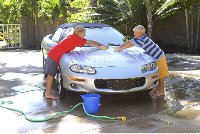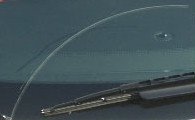HOW TO PROTECT AND CARE FOR YOUR CAR
OVER THE WINTER
Salt - One Of Your Cars' Worst Enemies
While most of us cringe at the thought of using a local hand wash garage,
most good hand car washes offer a high-pressure wash to flush the underside
of your vehicle if you ask them to.
| If you don't have a hand car wash
within your area or even one that will be prepared to offer you an
undercarriage wash, find a do-it-yourself wash and use the
high-pressure hose that you would normally use to wash the body
with, alternatively buy a head attachment for your hose pipe at home
to flush the underside of the car as best as possible.
We would recommend you wash your car as
often as possible in winter as many of us tend to slack off from our
regular wash routine in the winter months because of the cold, wet
weather. |
 |
When you are blessed with a dry day, try and
find the time to wash or have your car washed. Easier said than done, we
know but well worth the time.
Protect Against The Harsh Winter
Weather
Keeping your car waxed/sealed and the rubber and vinyl treated is the best
way to maintain a healthy exterior finish.
Traditional carnauba based waxes may not hold up in harsh winter conditions,
so if you have not already done so, you may wish to change over to a
synthetic wax or sealant for winter protection.
Unlike carnauba waxes, a
polymer or acrylic resin sealant can shield against water and road
salts. A high quality sealant should last through about three months of a
harsh winter.
 |
Additionally application of wax is
not as effective in the winter months due to the low temperatures,
unless of course you have a heated garage you can work in. However
we would recommend that you still make this one of your winter care
jobs as it is better to have some protection, than none at all.
Quick detailer sprays are also a
great way to buff up the paint and restore a thin film of protection
as well. |
Other parts of your cars' exterior such as
the bumpers, trim and rubber door seals also need extra protection when the
temperature drops. These materials are affected by extreme temperatures and
the sun's ultraviolet (UV) radiation. UV radiation causes fading, hardening
and cracking, especially in the winter with a reduced ozone layer. When
properly maintained; door, bonnet and boot seals will maintain their shape
and elasticity longer, providing a better seal. There are products on the
market specially formulated and designed to protect and maintain your cars
rubber seals.
Interior - Although Inside, They Also
Need More Care In Winter
Winter is also hard on car interiors. The cold, dry air of winter also tends
to pull out the moisture from your leather and vinyl. It therefore also
important to treat the interior prior to the onset of freezing temperatures.
Once the daytime temperatures dip to near freezing, leather and vinyl will
not gain a lot of benefit from the application of conditioners at that
temperature, we would therefore advise you get this done now whilst we have
a relatively mild spell.
Wheels & Tyres - At The Sharp End Of
The Harsh Winter Weather
Your cars' tyres are also exposed to the full force of winter elements.
Liberal use of a high quality tyre dressing not only
keeps them looking good during the harshest weather but also provides a
barrier to the elements and to ozone, that can cause rubber to deteriorate.
Use a dressing with good a UV protection system built in to ensure adequate
protection. Apply to both front and back of tyres with a liberal application
of dressing. Allow the dressing to soak in for good 5 to 10 minutes before
wiping off the excess, during winter the tyre dressing make take longer to
cure, some in some cases the 5 to 10 minutes may not be long enough.
| Inspect your windshield wipers
before the snow and rain come. Replace them if there's any sign of
wear.
While you're at it, check your wash fluid and add a winter
screen wash making sure you put at least double the normal dose in
due to the freezing temperature's and check that antifreeze. A good
winter screen wash will help cut through road salt, road grime and
mud. |
 |
Whilst on the subject of windscreens and
freezing it is always worthwhile carrying a bottle of De-Icer in your car as
well as having one in the house (in case your locks freeze as well). Our
personal favourite is one which is effective up to -50 degrees and safe on
paintwork, plastics and rubber.
Other practical steps to keep you safe
and motoring
If your car is more than five years old, make sure you check the battery.
Every winter, there comes those especially brutal sub-zero morning's that
drains the last bit of power from any weak car battery. Even if your battery
is relatively new, you should inspect it before winter arrives. Make certain
the terminals and posts are free of corrosion (clean with baking soda and
water), the terminals are tight and then spray with a lubricating protectant.
Consider investing in a battery conditioner/charger, especially if your
motor is being garaged over the winter. Unlike normal chargers, battery
conditioners have clever electronics that detects the exact condition of the
battery and will provide just enough charge to keep it topped up and at
optimum performance without the danger of being able to damage the battery
by overcharging. Something that can all too often happen with a simple
battery charger.
Have the cooling system checked for the correct concentration and level of
antifreeze. If your vehicle needs additional coolant, follow the
manufacturer's recommendation for the ratio of water to coolant. If your
coolant is more than two years old, it should be flushed and refilled.
Changing the oil and filter before winter is the single most important
step in prolonging your vehicle's engine life. Most manufacturers
recommend an oil change every 5,000 to 15,000 miles or once a year,
whichever comes first. Your oil service interval will depend on the age and
manufacturer of your car.
And finally to your rubber gear
 |
Worn tyres won't give you the
traction you need on wet, icy roads.
If your tyres are worn, replace them
with a good set of all-weather tyres.
For extra grip in the snow, get a set
of snow tyres. Snow tyres should always be used in a complete set of
four. |
If you live in a rural area you may want to
keep a set of tyre chains in your boot, just in case! Likewise, correct tyre
pressure ensures optimum handling, stopping power and unnecessary wear.
Remember to check pressure frequently because cold air causes it to drop.
As you can see there are a myriad of products
available to
clean and protect your vehicle, whether it be paintwork, chrome, tyres
or trims.
When travelling in winter, remember to always carry
with you an ice scraper, de-icer, waterproof jacket, warning signs, some
small snacks to eat, warm flask, boots and a thick blanket just in case you
get stuck in any snow.
Copyright © 2000-2020
Hints and Things
All Rights Reserved.
No portion of this site may be reproduced or redistributed without prior
written permission from Hints and Things. All trademarks & copyrights
throughout Hints and Things remain the property of their respective
owners.
Hints and Things cannot be
held responsible for any information given on this site nor do they
necessarily agree with, or endorse, the views given by third parties. |

